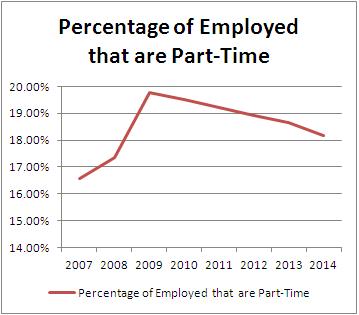Since the end of 2007, the amount of Americans working part-time has jumped 2.2 million, from 24.4 million to 26.6 million, even as the amount of people working has actually decreased by 286,000, according to the latest data compiled by the Bureau of Labor Statistics.
As a result, the percentage of those employed working part-time has jumped from 16.6 percent to 18.2 percent this year. Part-timers as a percent of workers peaked in 2009 at 19.8 percent and has only been slowly declining since, illustrative of the weak recovery.
At its current rate, it might take another two to three years just for it to get back to its 2007 levels. By then, it will have been a decade since the financial crisis, and a lost decade at that — like Japan’s. Why?
Since 2007, the civilian noninstitutional population has grown by 14.6 million. No jobs have been created.
The situation would be even worse if not for the surge of part-time jobs. But even the availability of those has been decreasing — by 1.2 million since 2009.
That is, until last month. Although the amount of those with jobs increased by 476,000, it turns out that a whopping 414,000 of those were part-time, the largest monthly increase in almost two years.
Put another way, 87 percent of the jobs created last month were part-time.
On one hand, this could mean that employers are sticking a toe in the water and bringing people on part-time. However, it may not necessarily be a good thing, as the increase of part-timers in 2007 foretold the coming collapse in 2008.
Yet, as Alex Planes at the finance blog Motley Fool notes, “This could just as well be an aberration, as it was a year ago.”
But, he added, “the part-time picture in the American workforce is far from rosy. The financial crisis resulted in a spike in the number of part-time workers as a percentage of the labor force, and this has remained elevated ever since. In fact, it might be said that the ‘part-timing’ of American jobs has held back a stronger workforce recovery, as the number of full-time equivalent jobs — calculated by combining total employment by average hours worked, and then dividing that figure by 40 — is a bit further away from full recovery than the baseline employment figure.”
All of which adds up to? “The slowest jobs recovery since the Great Depression,” reports Planes, concluding, “Americans are still working less than they were in 2008. Many of the jobs they’re finding don’t pay a whole lot of money. And millions of people continue to go many months without ever finding a job.”
All this, after trillions of fiscal and monetary stimulus by Congress and Federal Reserve, bank bailouts, and the kitchen sink was thrown at fixing the economy.
There’s nothing wrong with honest, part-time work. But an economy that forces Americans to delay their dreams for half a decade and maybe more waiting for recovery is nothing to celebrate.
Robert Romano is the senior editor of Americans for Limited Government.







